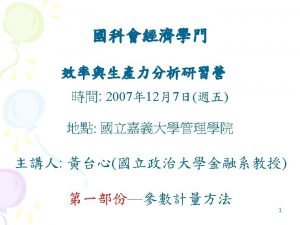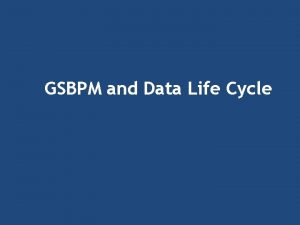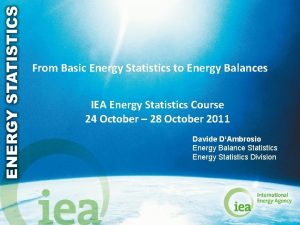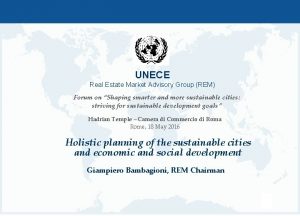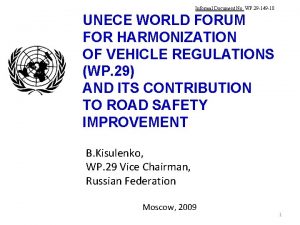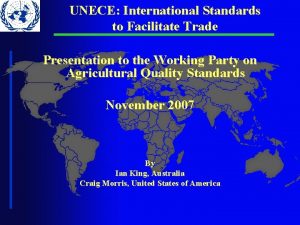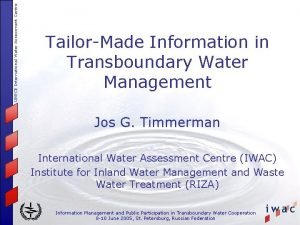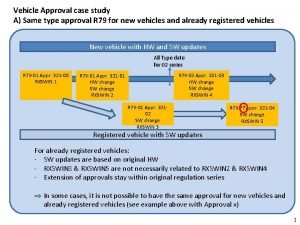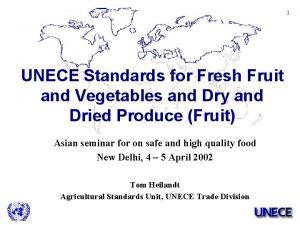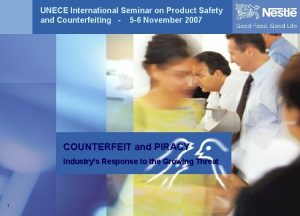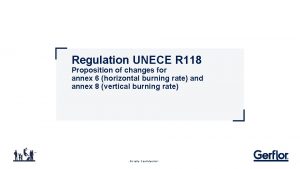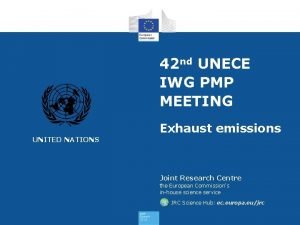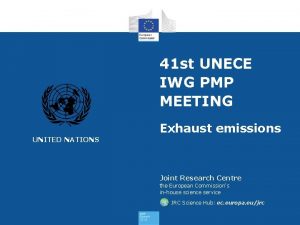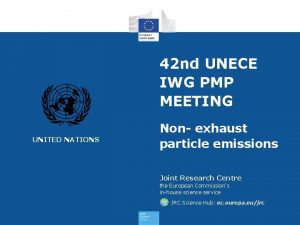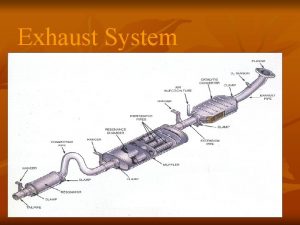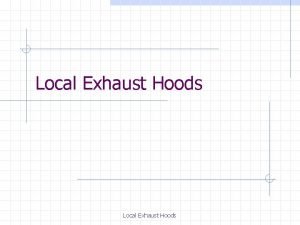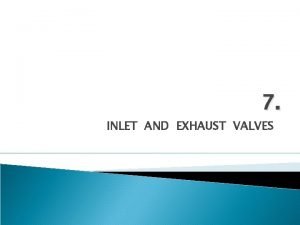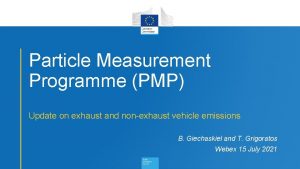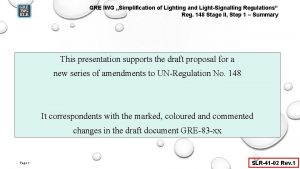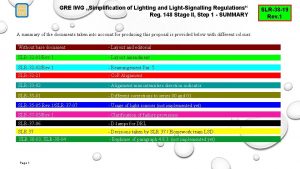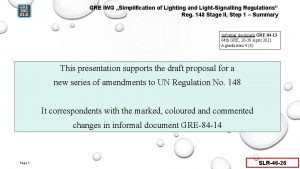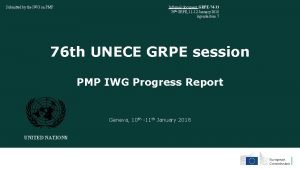38 th UNECE IWG PMP MEETING Exhaust emissions















- Slides: 15

38 th UNECE IWG PMP MEETING Exhaust emissions UNITED NATIONS Joint Research Centre the European Commission's in-house science service JRC Science Hub: ec. europa. eu/jrc

PMP meetings 4 th-5 th March 2015 (Brussels): 36 th PMP meeting 7 th– 8 th October 2015 (Brussels): 37 th PMP meeting 13 th January 2016 (Geneva) : 38 th PMP meeting 9 th-10 th March 2016 (Brussels) : 39 th PMP meeting 2

PN Counting from Raw Exhaust via Fixed Dilution • Interest in this approach confirmed by some engine manufacturers and some instrument manufacturers • 01 Series of amendments to Reg. 132 already includes such possibility but the procedure is not defined • First analysis of potential benefits/issues presented during the last meetings • Correlation with other methods (CVS and partial flow system) and advantages/disadvantages to be checked – Additional data required 3 3

Raw exhaust (tailpipe) sampling • Experimental program o o o Primary dilution Losses Volatile removal efficiency Pressure effects Time alignment • Interested parties are expected to generate experimental data to be then discussed within the PMP group • Limited number of tests planned at the JRC from PN-PEMS for HD program 4

WLTP PM/PN definitions The term ‘particle’ is conventionally used for the matter being characterised (measured) in the airborne phase (suspended matter), and the term ‘particulate’ for the deposited matter. "Particle number emissions" (PN) means the total number of solid particles emitted from the vehicle exhaust quantified according to the dilution, sampling and measurement methods as specified in this gtr. "Particulate matter emissions" (PM) means the mass of any particulate material from the vehicle exhaust quantified according to the dilution, sampling and measurement methods as specified in this gtr; 5

Calibration of PN systems • Review of open issues (30 th) • Presentation of key areas (33 rd) • Questionnaire sent for optimizing procedures and minimizing areas of future investigation • Participants presentations • Summary of first replies (35 th) • Few remaining open issues: o Volatile removal efficiency (new test to be evaluated) o Calibration material for PNCs (Round Robin in 2016 being organized by JRC in collaboration with inst. manufacturers) o Applicable also to 10 nm and PN-PEMS 6

Sub 23 nm measurements Is there a need? • Literature review: Emission levels of sub 23 nm (30 th) o There are particles <23 nm • Experimental investigation at JRC (30 th – 32 nd +) o There are particles <23 nm o Sometimes they are an artifact o “Real particles” are on average 30 -40% on average over a test cycle • Monitoring of newer technologies goes on (at JRC) o o Previous results confirmed (Tests >40 vehicles) GDIs sub 23 nm fraction is on average 30 -40% Higher for PFIs. Even higher for 2 -stroke mopeds PMP 23 generally sees high emitters (no extreme cases with all 7 particles <23 nm)

Sub 23 nm: Monitoring Tendency of higher ratio at lower concentrations DPF (no) 8

Sub 23 nm measurements Can we measure <23 nm? • Theoretical investigation: Feasibility of existing PN systems to measure <23 nm (30 th). • Experimental investigation at JRC o Artifacts were confirmed o Existing systems with small modification can measure below 23 nm (from 10 nm) o Below 10 nm the measurements will have high uncertainty o From 10 nm some areas need investigation like: o -PCRF definition same if down to 10 nm (and controlled losses <23 nm) o -Specification of >10 nm systems ok (catalytic stripper highly recommended especially if all cases need to be covered e. g. 2 -stroke engines) o -Catalytic stripper Draft specifications ready o -New need of calibration procedures under investigation if necessary 9

Sub 23 nm measurements New EU projects will also address the issue • Horizon 2020 - Call : H 2020 -GV-2016 -2017 • Scope - Proposals should address one of the following domains: o New generation of non-hybrid engines based on existing engine technologies (short term developments) - Future combustion engines for electrified powertrains (longer term developments). Special attention should be given to the assessment and reduction of particle emissions below 23 nm, particularly for direct injection gasoline and diesel engines. o Development (based on current direct injection engines) of the related measurement procedures down to 10 nm, providing a contribution to future regulation on particle emissions, in particular in real driving conditions. 10

Regeneration • Presentation of potential issues related to the measurement of PN during regeneration (30 th) • Robustness of PMP 10 nm (35 th) • Confirmed again in 2016 11

Key conclusions • Raw exhaust sampling for HD Input to JRC is needed based on suggested program • Calibration PMP: Open: Material for PNC, Volatile Removal efficiency on-going • Sub-23 nm: Percentages tend to increase compared to diesel. Not critical (except 2 -s engines) • Sub-23 nm systems: Ready. Minor details missing for CS investigations (SO 2 -SO 3 conversion) • Regeneration: Robustness of PMP systems down to 10 nm 12

Key messages Need to lower the 23 nm? • For GDIs 30 -40% not counted (50% taking into account losses), higher in some cases e. g. higher ethanol concentration • For motorcycles >200% particles are not counted • For PFIs 50 -100% • For DPFs this percentage is 5%. • High emitters are still detected by PMP 23 nm • Thus not critical yet for current regulated technologies 13

Key messages A change at this point (eg with WLTP? ) would make sense: • If other technologies will be included in PN future regulation • PN-PEMS are being finalized, thus a change to 10 nm could be considered • Calibration procedures are being updated now A change at this point would have some difficulties • Sub 23 nm particles will be measured only partly due to losses in the PN systems (estimation 50%) • A catalytic stripper is not necessary for current technologies but necessary if others will be covered in the future. Long term experience is lacking 14

Stay in touch JRC Science Hub: ec. europa. eu/jrc You. Tube: JRC Audiovisuals Twitter and Facebook: @EU_Science. Hub Vimeo: Science@EC Linked. In: european-commission-joint-research-centre 15


